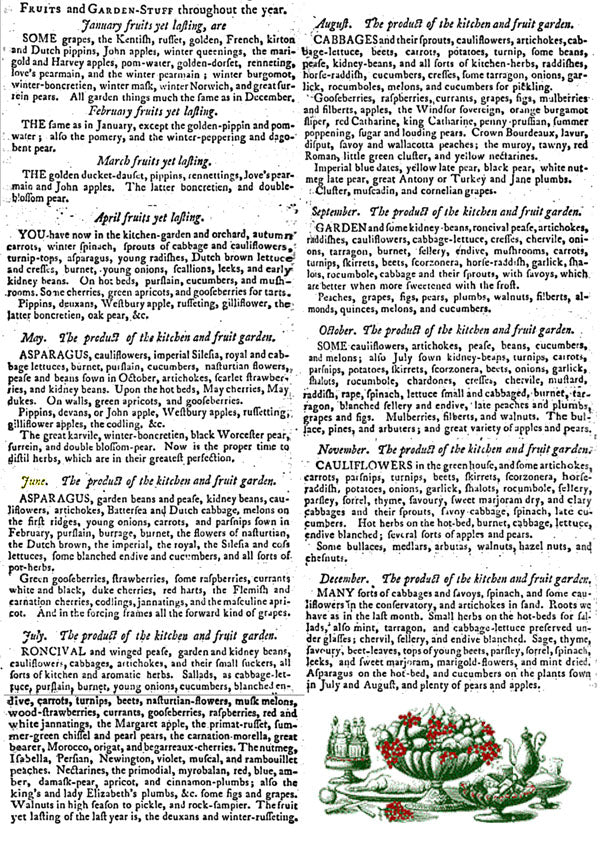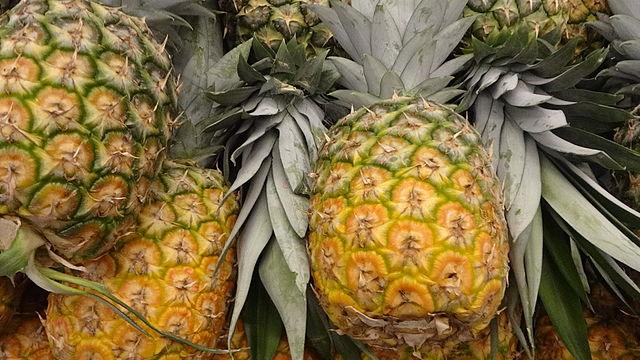Plant a Regency Kitchen Garden
I consider the kitchen garden as of very considerable importance as pot herbs, sallads, and roots of various kinds are useful in housekeeping. Having plenty of them at hand, a family will not be so likely to run into the error, which is too common in the country, of eating flesh in too great a proportion to health. Samuel Deane, 1822 
Cottage gardens, like those at Chawton combine flower and vegetable plants with happy abandon. Tomatoes and beans share space with Blackeyed Susans and Delphinium. Herbs grow with wild abandon among the borders and fruit trees and bushes are planted for beauty as much as fruitfulness. On larger estates, specific tracts of lands, often several acres, were given over to the cultivation of all the "sallads and green things" to be eaten by the family over the course of the year. Cold frames, green houses and hot houses allowed for more exotic fruits and longer growing seasons. Specialized buildings, like Northanger Abbey's Pinery allowed pineapples and other unobtainable fruits to be grown at hand. Here, behind fences or walls, to deter both human and animal theft, the gardener would cultivate all manner of vegetable, herb and useful flower. Considering that most of what was eaten on the manner throughout the year came from these crops, it was a job of no mean importance. Many of the fruits used in the daily housekeeping would have also been grown in the kitchen garden-- it was common to grown fruit trees trained along the walls of the garden or house --as these photos from the Chawton Great House show. Donwell Abbey's gardens also boasted a separate orchard and strawberry beds.  In The Art of Cookery Made Plain and Easy. (1747), Hannah Glasse gives the following list of garden edibles by month, thereby giving an idea of what would be grown in a well stocked kitchen garden of the time.
In The Art of Cookery Made Plain and Easy. (1747), Hannah Glasse gives the following list of garden edibles by month, thereby giving an idea of what would be grown in a well stocked kitchen garden of the time.  The easiest way to create a kitchen garden of Austen's era is to combine heirloom vegetable plants along with the flowers in a cottage garden setting, like we have described in another post. The vegetables currently grown at Chawton Cottage include: potatoes, cucumbers, runner beans, melons, squash (marrows), pumpkins, carrots, rhubarb, parsnips, beetroots, radishes, coriander, peas, onions, garlic and tomatoes. Heirloom seeds are relatively easy to find, thanks to the internet. Many sites, like the gift shop at Old Sturbridge Village, Heirloomseeds.com, and Realseeds.co.uk offer a wide variety of vegetables and flowers that are very close if not identical to the plants grown in Jane Austen's garden during her lifetime. Not only will you enjoy the benefits of homegrown goodness, you will experiance a variety of produce unknown in the commercially grown vegetables available at your local grocer's.
The easiest way to create a kitchen garden of Austen's era is to combine heirloom vegetable plants along with the flowers in a cottage garden setting, like we have described in another post. The vegetables currently grown at Chawton Cottage include: potatoes, cucumbers, runner beans, melons, squash (marrows), pumpkins, carrots, rhubarb, parsnips, beetroots, radishes, coriander, peas, onions, garlic and tomatoes. Heirloom seeds are relatively easy to find, thanks to the internet. Many sites, like the gift shop at Old Sturbridge Village, Heirloomseeds.com, and Realseeds.co.uk offer a wide variety of vegetables and flowers that are very close if not identical to the plants grown in Jane Austen's garden during her lifetime. Not only will you enjoy the benefits of homegrown goodness, you will experiance a variety of produce unknown in the commercially grown vegetables available at your local grocer's.
 For further information on planting your own Regency Kitchen garden or cottage garden, turn to In the Garden with Jane Austen by Kim Wilson.
For further information on planting your own Regency Kitchen garden or cottage garden, turn to In the Garden with Jane Austen by Kim Wilson.
If you don't want to miss a beat when it comes to Jane Austen, make sure you are signed up to the Jane Austen newsletter for exclusive updates and discounts from our Online Gift Shop.



2 comments
Good morning,
Do you know the name of the apple tree in Chawton’s garden ? Yellow sweet apple in august.
Thank you.
Iris
Found your post about plant kitchen garden interesting to read. I cant wait to see your post soon. Good Luck for the upcoming update.This article is really very interesting and effective.
plantdesign
Shalin designs
Leave a comment
This site is protected by hCaptcha and the hCaptcha Privacy Policy and Terms of Service apply.